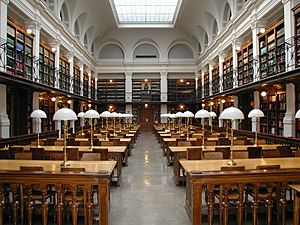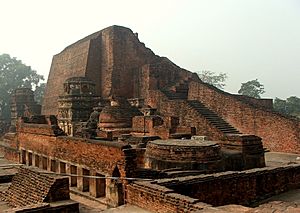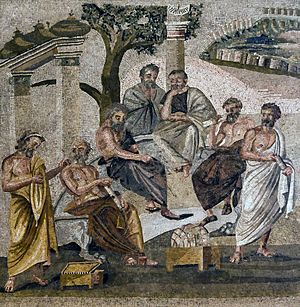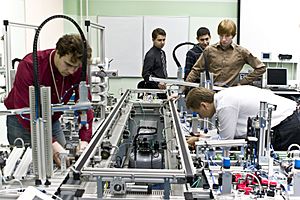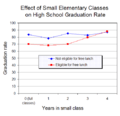Education facts for kids
Education is about teaching and learning skills and knowledge. Education also means helping people to learn how to do things and encouraging them to think about what they learn. It is also important for educators to teach ways to find and use information.
Through education, the knowledge of society, country, and of the world is passed on from generation to generation. In democracies, through education, children and adults are supposed to learn how to be active and effective citizens.
More specific, education helps and guide individuals to transform from one class to other. Empowered individuals, societies, countries by education are taking edge over individuals stand on bottom pyramid of growth.
There are different methods of categorizing types of education. One way is to divide it into formal education, non-formal education, and informal education.
Formal education is usually in school, where a person may learn basic, academic, or trade skills. Small children often attend a nursery or kindergarten but often formal education begins in elementary school and continues with secondary school. Post-secondary education (or higher education) is usually at a college or university which may grant an academic degree.
Non-formal education includes adult basic education, adult literacy education or school equivalency preparation. In nonformal education someone (who is not in school) can learn literacy, other basic skills or job skills. Home education, individualized instruction (such as programmed learning), distance learning and computer-assisted instruction are other possibilities.
Informal education may be a parent teaching a child how to prepare a meal or ride a bicycle. People can also get an informal education by reading many books from a library or educational websites. Informal education is when you are not studying in a school and do not use any particular learning method.
Many public schools provide a free education through the government. Parents may send their children to a private schools, but they must pay for it. In some poorer places, some children cannot go to school, because their countries do not make education available in their countries, or because their families do not have enough money, or because the children have to work for money, or because the society have negative prejudice on education for girls.
There are primary schools and secondary schools. In many places they are government funded. Colleges and universities usually charge Tuition payments which may be very different in different countries.
Contents
History
Education began in prehistory, as adults trained the young in the knowledge and skills deemed necessary in their society. In pre-literate societies, this was achieved orally and through imitation. Story-telling passed knowledge, values, and skills from one generation to the next. As cultures began to extend their knowledge beyond skills that could be readily learned through imitation, formal education developed. Schools existed in Egypt at the time of the Middle Kingdom.
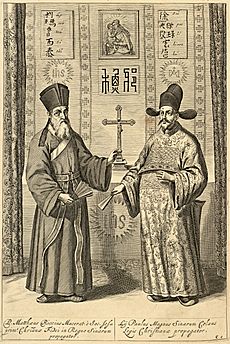
Plato founded the Academy in Athens, the first institution of higher learning in Europe. The city of Alexandria in Egypt, established in 330 BCE, became the successor to Athens as the intellectual cradle of Ancient Greece. There, the great Library of Alexandria was built in the 3rd century BCE. European civilizations suffered a collapse of literacy and organization following the fall of Rome in CE 476.
In China, Confucius (551–479 BCE), of the State of Lu, was the country's most influential ancient philosopher, whose educational outlook continues to influence the societies of China and neighbours like Korea, Japan, and Vietnam. Confucius gathered disciples and searched in vain for a ruler who would adopt his ideals for good governance, but his Analects were written down by followers and have continued to influence education in East Asia into the modern era.
After the Fall of Rome, the Catholic Church became the sole preserver of literate scholarship in Western Europe. The church established cathedral schools in the Early Middle Ages as centres of advanced education. Some of these establishments ultimately evolved into medieval universities and forebears of many of Europe's modern universities. During the High Middle Ages, Chartres Cathedral operated the famous and influential Chartres Cathedral School. The medieval universities of Western Christendom were well-integrated across all of Western Europe, encouraged freedom of inquiry, and produced a great variety of fine scholars and natural philosophers, including Thomas Aquinas of the University of Naples, Robert Grosseteste of the University of Oxford, an early expositor of a systematic method of scientific experimentation, and Saint Albert the Great, a pioneer of biological field research. Founded in 1088, the University of Bologne is considered the first, and the oldest continually operating university.
Elsewhere during the Middle Ages, Islamic science and mathematics flourished under the Islamic caliphate which was established across the Middle East, extending from the Iberian Peninsula in the west to the Indus in the east and to the Almoravid Dynasty and Mali Empire in the south.
The Renaissance in Europe ushered in a new age of scientific and intellectual inquiry and appreciation of ancient Greek and Roman civilizations. Around 1450, Johannes Gutenberg developed a printing press, which allowed works of literature to spread more quickly. The European Age of Empires saw European ideas of education in philosophy, religion, arts and sciences spread out across the globe. Missionaries and scholars also brought back new ideas from other civilizations – as with the Jesuit China missions who played a significant role in the transmission of knowledge, science, and culture between China and Europe, translating works from Europe like Euclid's Elements for Chinese scholars and the thoughts of Confucius for European audiences. The Enlightenment saw the emergence of a more secular educational outlook in Europe.
In most countries today, full-time education, whether at school or otherwise, is compulsory for all children up to a certain age. Due to this the proliferation of compulsory education, combined with population growth, UNESCO has calculated that in the next 30 years more people will receive formal education than in all of human history thus far.
Formal education
Formal education occurs in a structured environment whose explicit purpose is teaching students. Usually, formal education takes place in a school environment with classrooms of multiple students learning together with a trained, certified teacher of the subject. Most school systems are designed around a set of values or ideals that govern all educational choices in that system. Such choices include curriculum, organizational models, design of the physical learning spaces (e.g. classrooms), student-teacher interactions, methods of assessment, class size, educational activities, and more.
Preschool
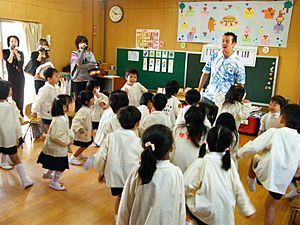
Preschools provide education from ages approximately three to seven, depending on the country when children enter primary education. These are also known as nursery schools and as kindergarten, except in the US, where kindergarten is a term used for primary education. Kindergarten "provide[s] a child-centred, preschool curriculum for three- to seven-year-old children that aim[s] at unfolding the child's physical, intellectual, and moral nature with balanced emphasis on each of them."
Primary
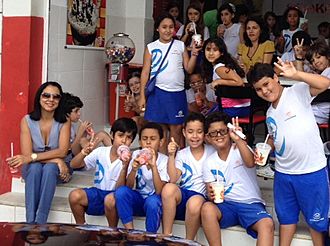
Primary (or elementary) education consists of the first five to seven years of formal, structured education. In general, primary education consists of six to eight years of schooling starting at the age of five or six, although this varies between, and sometimes within, countries. Globally, around 89% of children aged six to twelve are enrolled in primary education, and this proportion is rising. Under the Education For All programs driven by UNESCO, most countries have committed to achieving universal enrollment in primary education by 2015, and in many countries, it is compulsory. The division between primary and secondary education is somewhat arbitrary, but it generally occurs at about eleven or twelve years of age. Some education systems have separate middle schools, with the transition to the final stage of secondary education taking place at around the age of fourteen. Schools that provide primary education, are mostly referred to as primary schools or elementary schools. Primary schools are often subdivided into infant schools and junior school.
In India, for example, compulsory education spans over twelve years, with eight years of elementary education, five years of primary schooling and three years of upper primary schooling. Various states in the republic of India provide 12 years of compulsory school education based on a national curriculum framework designed by the National Council of Educational Research and Training.
Secondary

In most contemporary educational systems of the world, secondary education comprises the formal education that occurs during adolescence. It is characterized by transition from the typically compulsory, comprehensive primary education for minors, to the optional, selective tertiary, "postsecondary", or "higher" education (e.g. university, vocational school) for adults. Depending on the system, schools for this period, or a part of it, may be called secondary or high schools, gymnasiums, lyceums, middle schools, colleges, or vocational schools. The exact meaning of any of these terms varies from one system to another. The exact boundary between primary and secondary education also varies from country to country and even within them but is generally around the seventh to the tenth year of schooling. Secondary education occurs mainly during the teenage years. In the United States, Canada, and Australia, primary and secondary education together are sometimes referred to as K-12 education, and in New Zealand Year 1–13 is used. The purpose of secondary education can be to give common knowledge, to prepare for higher education, or to train directly in a profession.
Secondary education in the United States did not emerge until 1910, with the rise of large corporations and advancing technology in factories, which required skilled workers. In order to meet this new job demand, high schools were created, with a curriculum focused on practical job skills that would better prepare students for white collar or skilled blue collar work. This proved beneficial for both employers and employees, since the improved human capital lowered costs for the employer, while skilled employees received higher wages.
Secondary education has a longer history in Europe, where grammar schools or academies date from as early as the 16th century, in the form of public schools, fee-paying schools, or charitable educational foundations, which themselves date even further back.
Community colleges offer another option at this transitional stage of education. They provide nonresidential junior college courses to people living in a particular area.
Tertiary (higher)
Higher education, also called tertiary, third stage, or postsecondary education, is the non-compulsory educational level that follows the completion of a school such as a high school or secondary school. Tertiary education is normally taken to include undergraduate and postgraduate education, as well as vocational education and training. Colleges and universities mainly provide tertiary education. Collectively, these are sometimes known as tertiary institutions. Individuals who complete tertiary education generally receive certificates, diplomas, or academic degrees.
Higher education typically involves work towards a degree-level or foundation degree qualification. In most developed countries, a high proportion of the population (up to 50%) now enter higher education at some time in their lives. Higher education is therefore very important to national economies, both as a significant industry in its own right and as a source of trained and educated personnel for the rest of the economy.
University education includes teaching, research, and social services activities, and it includes both the undergraduate level (sometimes referred to as tertiary education) and the graduate (or postgraduate) level (sometimes referred to as graduate school). Universities are generally composed of several colleges. In the United States, universities can be private and independent like Yale University; public and state-governed like the Pennsylvania State System of Higher Education; or independent but state-funded like the University of Virginia. A number of career specific courses are now available to students through the Internet.
One type of university education is a liberal arts education, which can be defined as a "college or university curriculum aimed at imparting broad general knowledge and developing general intellectual capacities, in contrast to a professional, vocational, or technical curriculum." Although what is known today as liberal arts education began in Europe, the term "liberal arts college" is more commonly associated with institutions in the United States.
Vocational
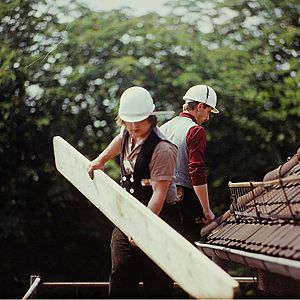
Vocational education is a form of education focused on direct and practical training for a specific trade or craft. Vocational education may come in the form of an apprenticeship or internship as well as institutions teaching courses such as carpentry, agriculture, engineering, medicine, architecture and the arts.
Special
In the past, those who were disabled were often not eligible for public education. Children with disabilities were repeatedly denied an education by physicians or special tutors. These early physicians (people like Itard, Seguin, Howe, Gallaudet) set the foundation for special education today. They focused on individualized instruction and functional skills. In its early years, special education was only provided to people with severe disabilities, but more recently it has been opened to anyone who has experienced difficulty learning.
Other educational forms
Alternative
While considered "alternative" today, most alternative systems have existed since ancient times. After the public school system was widely developed beginning in the 19th century, some parents found reasons to be discontented with the new system. Alternative education developed in part as a reaction to perceived limitations and failings of traditional education. A broad range of educational approaches emerged, including alternative schools, self learning, homeschooling, and unschooling. Example alternative schools include Montessori schools, Waldorf schools (or Steiner schools), Friends schools, Sands School, Summerhill School, Walden's Path, The Peepal Grove School, Sudbury Valley School, Krishnamurti schools, and open classroom schools. Charter schools are another example of alternative education, which have in the recent years grown in numbers in the US and gained greater importance in its public education system.
In time, some ideas from these experiments and paradigm challenges may be adopted as the norm in education, just as Friedrich Fröbel's approach to early childhood education in 19th-century Germany has been incorporated into contemporary kindergarten classrooms. Other influential writers and thinkers have included the Swiss humanitarian Johann Heinrich Pestalozzi; the American transcendentalists Amos Bronson Alcott, Ralph Waldo Emerson, and Henry David Thoreau; the founders of progressive education, John Dewey and Francis Parker; and educational pioneers such as Maria Montessori and Rudolf Steiner, and more recently John Caldwell Holt, Paul Goodman, Frederick Mayer, George Dennison, and Ivan Illich.
Indigenous
Indigenous education refers to the inclusion of indigenous knowledge, models, methods, and content within formal and non-formal educational systems. Often in a post-colonial context, the growing recognition and use of indigenous education methods can be a response to the erosion and loss of indigenous knowledge and language through the processes of colonialism. Furthermore, it can enable indigenous communities to "reclaim and revalue their languages and cultures, and in so doing, improve the educational success of indigenous students."
Informal learning
Informal learning is one of three forms of learning defined by the Organisation for Economic Co-operation and Development (OECD). Informal learning occurs in a variety of places, such as at home, work, and through daily interactions and shared relationships among members of society. For many learners, this includes language acquisition, cultural norms, and manners. Informal learning for young people is an ongoing process that also occurs in a variety of places, such as out of school time, in youth programs at community centres and media labs.
Informal learning usually takes place outside educational establishments, does not follow a specified curriculum and may originate accidentally, sporadically, in association with certain occasions, from changing practical requirements. It is not necessarily planned to be pedagogically conscious, systematic and according to subjects, but rather unconsciously incidental, holistically problem-related, and related to situation management and fitness for life. It is experienced directly in its "natural" function of everyday life and is often spontaneous.
The concept of 'education through recreation' was applied to childhood development in the 19th century. In the early 20th century, the concept was broadened to include young adults but the emphasis was on physical activities. L.P. Jacks, also an early proponent of lifelong learning, described education through recreation: "A master in the art of living draws no sharp distinction between his work and his play, his labour and his leisure, his mind and his body, his education and his recreation. He hardly knows which is which. He simply pursues his vision of excellence through whatever he is doing and leaves others to determine whether he is working or playing. To himself, he always seems to be doing both. Enough for him that he does it well." Education through recreation is the opportunity to learn in a seamless fashion through all of life's activities. The concept has been revived by the University of Western Ontario to teach anatomy to medical students.
Open education and electronic technology
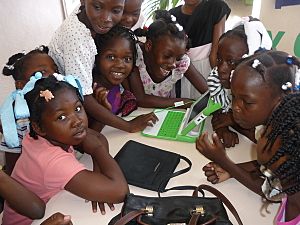
In 2012, the modern use of electronic educational technology (also called e-learning) had grown at 14 times the rate of traditional learning. Open education is fast growing to become the dominant form of education, for many reasons such as its efficiency and results compared to traditional methods. Cost of education has been an issue throughout history, and a major political issue in most countries today. Online courses often can be more expensive than face-to-face classes. Out of 182 colleges surveyed in 2009 nearly half said tuition for online courses was higher than for campus-based ones. Many large university institutions are now starting to offer free or almost free full courses such as Harvard, MIT and Berkeley teaming up to form edX. Other universities offering open education are Stanford, Princeton, Duke, Johns Hopkins, Edinburgh, U. Penn, U. Michigan, U. Virginia, U. Washington, and Caltech. It has been called the biggest change in the way we learn since the printing press. Despite favourable studies on effectiveness, many people may still desire to choose traditional campus education for social and cultural reasons.
The conventional merit-system degree is currently not as common in open education as it is in campus universities, although some open universities do already offer conventional degrees such as the Open University in the United Kingdom. Presently, many of the major open education sources offer their own form of certificate. Due to the popularity of open education, these new kind of academic certificates are gaining more respect and equal "academic value" to traditional degrees. Many open universities are working to have the ability to offer students standardized testing and traditional degrees and credentials.
A culture is beginning to form around distance learning for people who are looking to social connections enjoyed on traditional campuses. For example, students may create study groups, meetups, and movements such as UnCollege.
Economics of education
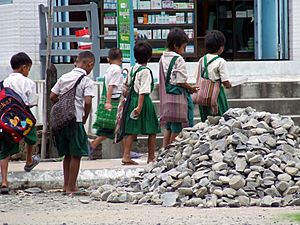
It has been argued that high rates of education are essential for countries to be able to achieve high levels of economic growth. Empirical analyses tend to support the theoretical prediction that poor countries should grow faster than rich countries because they can adopt cutting edge technologies already tried and tested by rich countries. However, technology transfer requires knowledgeable managers and engineers who are able to operate new machines or production practices borrowed from the leader in order to close the gap through imitation. Therefore, a country's ability to learn from the leader is a function of its stock of "human capital". Recent study of the determinants of aggregate economic growth have stressed the importance of fundamental economic institutions and the role of cognitive skills.
At the level of the individual, there is a large literature, generally related to the work of Jacob Mincer, on how earnings are related to the schooling and other human capital. This work has motivated a large number of studies, but is also controversial. The chief controversies revolve around how to interpret the impact of schooling. Some students who have indicated a high potential for learning, by testing with a high intelligence quotient, may not achieve their full academic potential, due to financial difficulties.
Economists Samuel Bowles and Herbert Gintis argued in 1976 that there was a fundamental conflict in American schooling between the egalitarian goal of democratic participation and the inequalities implied by the continued profitability of capitalist production.
The future of education
Many countries are now drastically changing the way they educate their citizens. The world is changing at an ever quickening rate, which means that a lot of knowledge becomes obsolete and inaccurate more quickly. The emphasis is therefore shifting to teaching the skills of learning: to picking up new knowledge quickly and in as agile a way as possible. Finnish schools have even begun to move away from the regular subject-focused curricula, introducing instead developments like phenomenon-based learning, where students study concepts like climate change instead.
Education is also becoming a commodity no longer reserved for children. Adults need it too. Some governmental bodies, like the Finnish Innovation Fund Sitra in Finland, have even proposed compulsory life-long education.
Images for kids
-
A high-school senior (twelfth grade) classrooms in Calhan, Colorado, United States
-
Universities often host prominent guest speakers for student audiences, e.g. First Lady of the United States Michelle Obama delivering remarks at Peking University, Beijing, China
-
A volunteer reads aloud to children in Laos.
-
Beijing Normal University, which is governed directly by the Chinese Ministry of Education, is an example of collaboration between different entities in the education sector.
-
Historical Madrasah in Baku, Azerbaijan
-
A class size experiment in the United States found that attending small classes for three or more years in the early grades increased high school graduation rates of students from low income families.
-
Knowledge Day in Donetsk, Ukraine, 2013
-
John Locke's work Some Thoughts Concerning Education was written in 1693 and still reflects traditional education priorities in the Western world.
See also
 In Spanish: Educación para niños
In Spanish: Educación para niños


